October 7 - 13, 2012: Issue 79
Superb Fairywren Colony at Careel Bay Playing Fields - Spring 2012
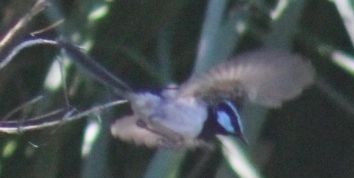 There are at least six pairs of Superb Fairywren (Malurus cyaneus) at Careel Bay playing fields in the regenerated bush and the overgrown lantana at present. They come out to say "Hi!" then flit away again. You can hear them telling pairs up and down the scrub beside the playing field that another person is peering into the bushes trying to catch a glimpse. Also known as the Superb Blue-wren or colloquially as the Blue Wren, these curious delightful tiny creatures are a passerine bird of the family Maluridae, and are considered common across southeastern Australia. Those shown here are a female and male in breeding plumage; during Spring they have a striking bright blue forehead, ear coverts, mantle, and tail, with a black mask and black or dark blue throat. Breeding males' blue plumage, particularly the ear-coverts, is highly iridescent because of the flattened and twisted surface of the barbules. The blue plumage also reflects ultraviolet light strongly, and so may be even more prominent to other fairywrens, whose colour vision extends into this part of the spectrum.
There are at least six pairs of Superb Fairywren (Malurus cyaneus) at Careel Bay playing fields in the regenerated bush and the overgrown lantana at present. They come out to say "Hi!" then flit away again. You can hear them telling pairs up and down the scrub beside the playing field that another person is peering into the bushes trying to catch a glimpse. Also known as the Superb Blue-wren or colloquially as the Blue Wren, these curious delightful tiny creatures are a passerine bird of the family Maluridae, and are considered common across southeastern Australia. Those shown here are a female and male in breeding plumage; during Spring they have a striking bright blue forehead, ear coverts, mantle, and tail, with a black mask and black or dark blue throat. Breeding males' blue plumage, particularly the ear-coverts, is highly iridescent because of the flattened and twisted surface of the barbules. The blue plumage also reflects ultraviolet light strongly, and so may be even more prominent to other fairywrens, whose colour vision extends into this part of the spectrum.
How birds see (1.): Most birds have exceptional colour vision. Humans distinguish colours based on our colour vision cells (cones) having three different color sensitivities. Because the colours we see are based on these three different types of cells, we call that trichromatic vision. Birds on the other hand usually have four different types of cones, with one kind of cone allowing them to see ultraviolet light—making the world a very different place for birds! It is important to remember that birds do not see colours like we do. In fact, birds like crows that all look the same to us, actually look very different to each other—since they can see patches of ultraviolet colouring that allows crows to distinguish males from females and even individual birds from each other.
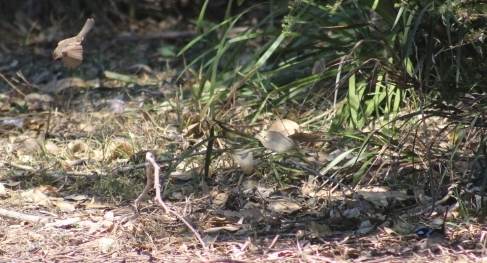 Non-breeding males, females and juveniles are predominantly grey-brown in colour; this gave the early impression that males were polygamous, as all dull-coloured birds were taken for females. Both sexes moult in autumn after breeding, with males assuming an eclipse non-breeding plumage. They moult again into nuptial plumage in winter or spring.
Non-breeding males, females and juveniles are predominantly grey-brown in colour; this gave the early impression that males were polygamous, as all dull-coloured birds were taken for females. Both sexes moult in autumn after breeding, with males assuming an eclipse non-breeding plumage. They moult again into nuptial plumage in winter or spring.
Like other fairywrens, the Superb Fairywren is notable for several peculiar behavioural characteristics; the birds are socially monogamous and sexually promiscuous, pairs will bond for life, though both males and females will regularly mate with other individuals; a proportion of young will have been fathered by males from outside the group. Young are often raised not by the pair alone, but with other males who also mated with the pair's female assisting. Male wrens have some wonderful courtship displays; they will pluck yellow petals and display them to females, are known for the 'sea horse flight', named for its seahorse-like undulations, during which the male—with his neck extended and his head feathers erect—tilts his body from horizontal to vertical, and descends slowly and springs upwards by rapidly beating his wings after alighting on the ground. The 'face fan' display is also noted as a part of sexual display behaviours; it involves the flaring of the blue ear tufts by erecting the feathers.
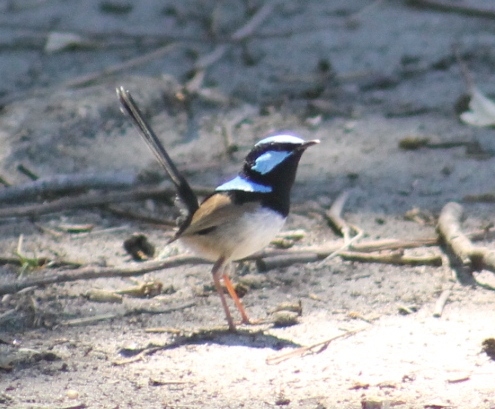 Breeding occurs from Spring through to late Summer; (2): the nest is a round or domed structure made of loosely woven grasses and spider webs, with an entrance in one side generally close to the ground, under 1 m (3 ft), and in thick vegetation. Two or more broods may be laid in an extended breeding season. A clutch of three or four matte white eggs with reddish-brown splotches and spots, easuring 12 x 16 mm (0.45 x 0.6 in). The eggs are incubated for 14 days, after which they hatch within 24 hours. Newborn chicks are blind, red and featherless, though quickly darken as feathers grow. Their eyes open by day five or six and are fully feathered by day 10. All group members feed and remove fecal sacs for 10–14 days. Fledglings are able to feed themselves by day 40 but remain in the family group as helpers for a year or more before moving to another group or assuming a dominant position in the original group. In this role they feed and care for subsequent broods and repel cuckoos or predators. Superb Fairywrens also commonly play host to the brood parasite Horsfield's Bronze Cuckoo (Chrysococcyx basalis) and, less commonly, the Shining Bronze Cuckoo (C. lucidus) and Fan-tailed Cuckoo (Cacomantis flabelliformis).
Breeding occurs from Spring through to late Summer; (2): the nest is a round or domed structure made of loosely woven grasses and spider webs, with an entrance in one side generally close to the ground, under 1 m (3 ft), and in thick vegetation. Two or more broods may be laid in an extended breeding season. A clutch of three or four matte white eggs with reddish-brown splotches and spots, easuring 12 x 16 mm (0.45 x 0.6 in). The eggs are incubated for 14 days, after which they hatch within 24 hours. Newborn chicks are blind, red and featherless, though quickly darken as feathers grow. Their eyes open by day five or six and are fully feathered by day 10. All group members feed and remove fecal sacs for 10–14 days. Fledglings are able to feed themselves by day 40 but remain in the family group as helpers for a year or more before moving to another group or assuming a dominant position in the original group. In this role they feed and care for subsequent broods and repel cuckoos or predators. Superb Fairywrens also commonly play host to the brood parasite Horsfield's Bronze Cuckoo (Chrysococcyx basalis) and, less commonly, the Shining Bronze Cuckoo (C. lucidus) and Fan-tailed Cuckoo (Cacomantis flabelliformis).
William Anderson, surgeon and naturalist on Captain James Cook's third voyage, collected the first Superb Fairywren specimen in 1777 while travelling off the coast of eastern Tasmania, in Bruny Island's Adventure Bay. He named it Motacilla cyaneabecause its tail reminded him of the European Wagtails of the genus Motacilla. Anderson did not live to publish his findings, although his assistant William Ellis described the bird in 1782. The genus Malurus was later described by Louis Jean Pierre Vieillot in 1816, giving the bird its current scientific name.
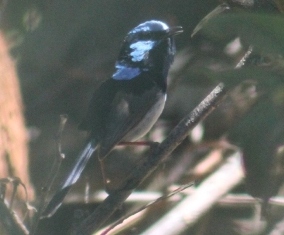 Shortly after the First Fleet's arrival at Port Jackson, Sydney, the bird gained the common name 'Superb Warbler'. In the 1920s came common names Wren and Wren-warbler—both from its similarity to the European Wren—and Fairywren. The bird has also been called Mormon Wren, a reference to observations of one blue-plumaged bird accompanied by many brown-plumaged birds, which were incorrectly assumed to be all female. The Ngarrindjeri people of the Murray River and Coorong regions called it Waatji pulyeri, meaning "little one of the waatji (lignum) bush", and the Gunai called it Deeydgun, meaning "little bird with long tail". Both it and the Variegated Fairywren were known as muruduwin the local Eora and Darug inhabitants of the Sydney basin.
Shortly after the First Fleet's arrival at Port Jackson, Sydney, the bird gained the common name 'Superb Warbler'. In the 1920s came common names Wren and Wren-warbler—both from its similarity to the European Wren—and Fairywren. The bird has also been called Mormon Wren, a reference to observations of one blue-plumaged bird accompanied by many brown-plumaged birds, which were incorrectly assumed to be all female. The Ngarrindjeri people of the Murray River and Coorong regions called it Waatji pulyeri, meaning "little one of the waatji (lignum) bush", and the Gunai called it Deeydgun, meaning "little bird with long tail". Both it and the Variegated Fairywren were known as muruduwin the local Eora and Darug inhabitants of the Sydney basin.
Like other fairywrens, the Superb Fairywren is unrelated to true wrens. It was previously classified as a member of the old world flycatcher family Muscicapidae and later as a member of the warbler family Sylviidae before being placed in the newly recognised Maluridae in 1975. Recent DNA analysis has shown the Maluridae family to be related to the Meliphagidae (honeyeaters), and the Pardalotidae (pardalotes, scrubwrens, thornbills, gerygones) in the large superfamily Meliphagoidea. The Superb Fairywren can be found in almost any area that has at least a little dense undergrowth for shelter, including grasslands with scattered shrubs, moderately thick forest, woodland, heaths, and domestic gardens. It has adapted well to the urban environment and is common in suburban Sydney, Canberra and Melbourne. They eat insects and seeds.
The Superb Fairywren is an emblem used by the Bird Observation & Conservation Australia. On 12 August 1999, a Superb Fairywren was mistakenly illustrated for an Australia Post 45c pre-stamped envelope meant to depict a Splendid Fairywren. Called the Blue Wren as it was then known, it had previously featured on a 2s.5d. stamp, released in 1964.
References
1. Fergus, Rob. Dr. 2010. How Birds See. Science Articles Base. Retrieved from: http://www.articlesbase.com/science-articles/how-birds-see-the-world-2829951.html
2. Superb Fairywren. (2012, September 14). In Wikipedia, The Free Encyclopedia. Retrieved from: http://en.wikipedia.org/w/index.php?title=Superb_Fairywren&oldid=512476551

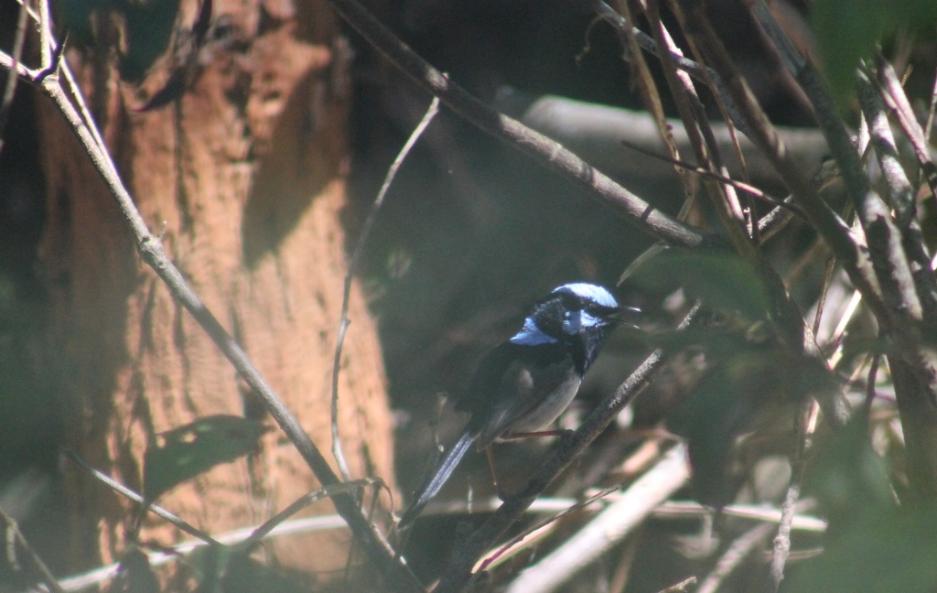
Male Superb Fairy Wren.
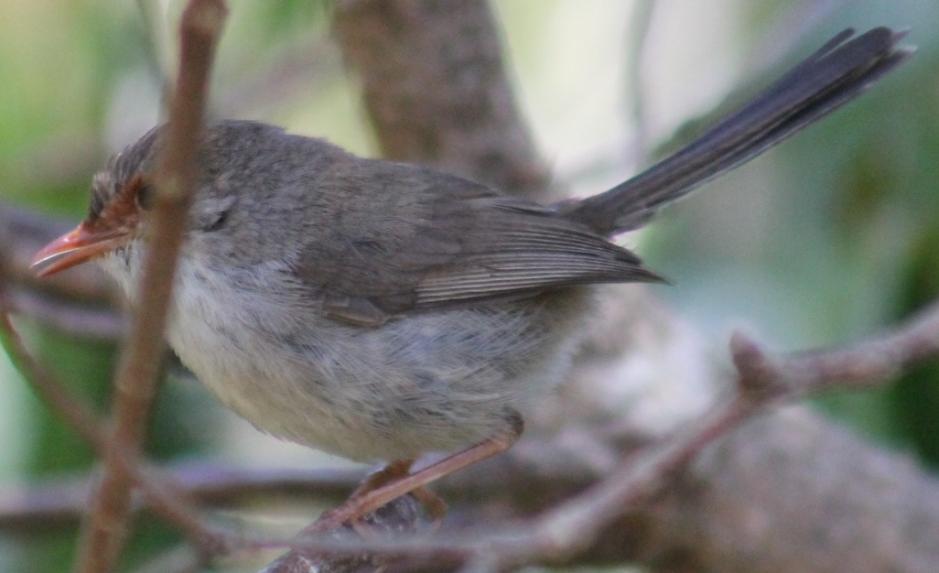
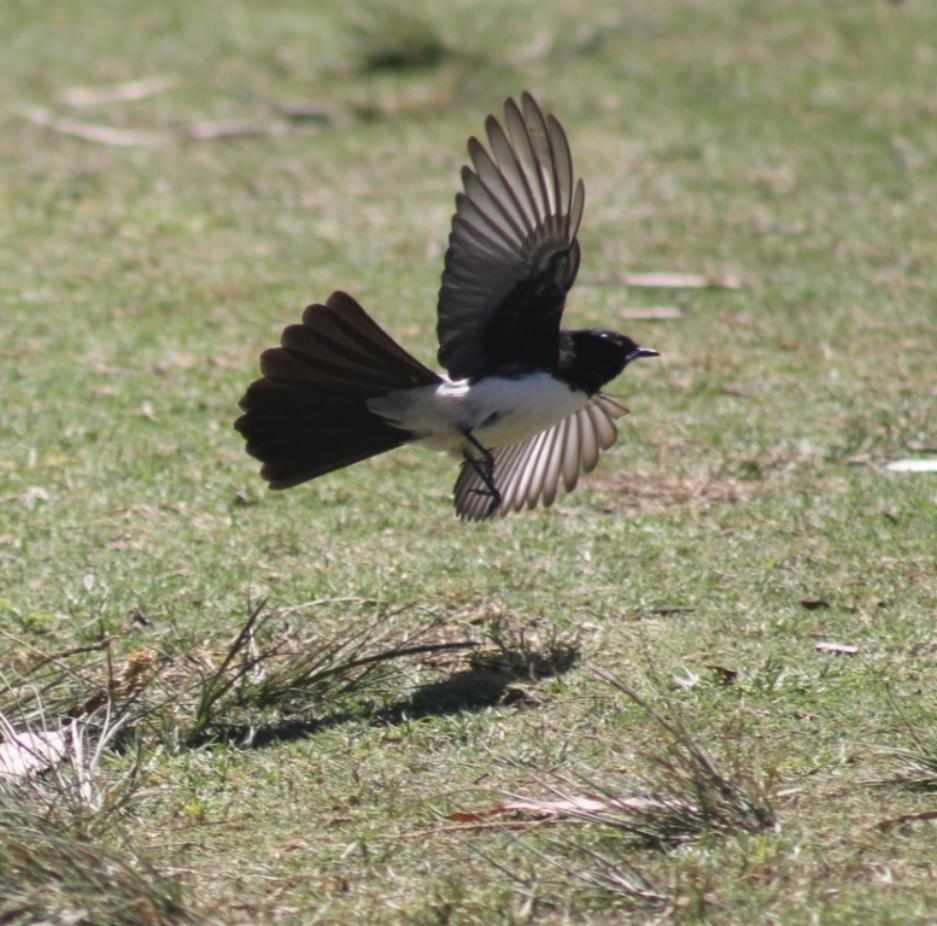
Willy Wagtail (Rhipidura leucophrys) photographed at Careel Bay the same day 4.10.2012
All photographs by A.J. Guesdon October, 2012. All Rights Reserved.